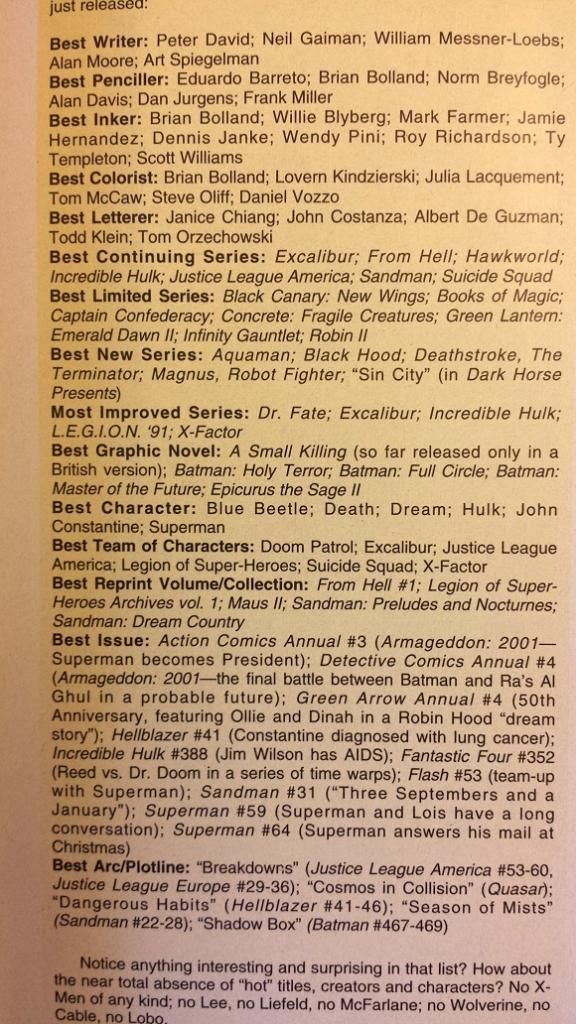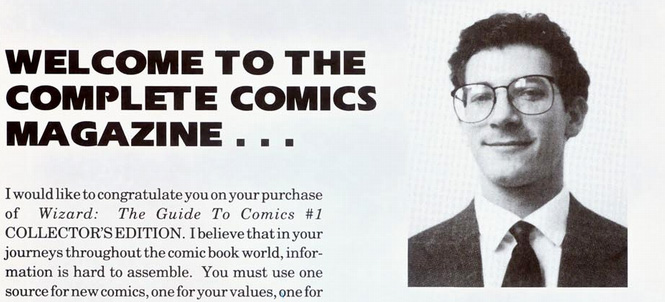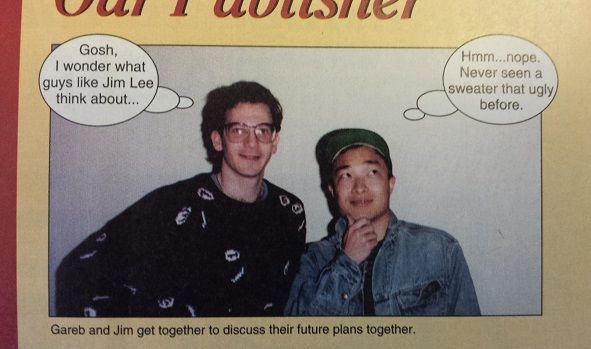Wizard #12 (August 1992)

The independents are taking over. It's really the one time that Wizard's hype machine and Wizard's fact-based Market Watch section actually agree. Valiant's Unity event has had a massive impact on the company's visibility (even without any help from Wizard), Image is knocking it out of the ballpark, John Byrne's Nextmen are garnering considerable attention, and Wizard is even highlighting Tundra as another potentially viable independent company championing creator's rights. It's an interesting and unsettling time in comics as the status quo is seemingly being overturned.
Meanwhile, Marvel is largely holding it's portion of the market, and everyone is seeing these new companies more as competition for DC's percentage of sales. It's no secret at this point that DC is in serious decline and appears to have no plans to regain its market shares as of yet (and people wonder what ultimately possessed them to pull a stunt like the death of Superman or the breaking of Batman?)
Patrick Daniel O'Neill continues to resist the hype, this time publishing the 1991 Thunderbolt Awards for Excellence in Comics nominees and outright pointing out that the more mature and well-read fans on the BBSes didn't pick any X-titles nor any "hot" artists in their awards. It could have been powerful stuff, but O'Neill's column has been relegated to a bland, visually boring page, sharing 50% of the page with an advertisement. His voice has been utterly silenced in the sense that any of the impressionable young fans he's trying to turn, dazzled by all the hype, are not going to read a boring text column with no pictures hidden next to an enormous (but equally bland) advertisement.
The Thunderbolt Awards for Excellence in Comics nominees:

It's an interesting and sad commentary on the era that most of the nominations are DC properties and creators, and yet DC is holding 24.6% of the market right now to Marvel's 52.8. Quality simply isn't selling, and DC is in danger of going the way of the dinosaur for not doing more to give into the hype.
Tom Palmer similarly keeps up the good fight to broaden the horizons of impressionable young readers by writing about how EC has inspired the comics of today, and even Patrick McCallum has changed his tune 180 degrees, trashing "crap" that has a fancy cover and calling upon fans not to buy this stuff, but it's pretty much a lost cause at this point. Everything else in this book is screaming "buy into the hype!", and let's not forget either that this issue came polybagged with a trading card.
(side note: this issue marked the first time I've ever opened a 20+ year old polybag. I'd heard the acidity of those things would ultimately hurt the book within, but it actually came out looking sharp and well preserved).
Another interesting note in this issue: last time around, Wizard grew a little too big for its britches and suddenly cut nearly all of the advertising it had previously designated for the comic book shops and dealers who had been its initial investors. Apparently, there was a backlash, as almost all of those ads are restored in this issue AND Wizard has launched the "Wizard Cool C.O.R.P.S.," a one page ad (otherwise never mentioned in the issue) promising that shopping from one of the 16 listed comic book vendors enables you to become a Cool C.O.R.P.S. member who receives discounts on merchandise, priority at special events, participation in Wizard's polls, questionaires, and feedback sessions, and "direct line news updates!" (whatever those might be).
Finally, is it just me, or is it painfully obvious that Shamus' nerdiness is, to some extent, an act? Whereas he looked relatively normal in the first issue, his crazy sweaters have gotten more ridiculous, his facial expressions more clueless, and yet he mocks these things himself in the photo blurbs, clearly acknowledging that he KNOWS how ridiculous he looks, and often seemingly staging these photos to have the person he's with look repulsed or weirded out. It seems to me that he's branding himself in an effort to play to his demographic -- nerdy adolescents. Again, I suspect that whoever provided the lion's share of funding to Wizard in order to get it started (
this article states that there were silent investors pulling all the strings, but it does not name names), chose to back Shamus and his team, not based on their resumes (they had none; see their "resumes"
here), but rather on the fact that they closely resembled the target demographic -- nerdy white boys. And thus, Shamus has very much become the mascot for the Wizard brand (moreso than the now forgotten "Poof" the Magician, who hasn't appeared nor been mentioned since probably the third issue). Most magazines don't advertise the identities of their publishers, but any 14 year old reader in 1992 could tell you the name, basic appearance, and supposed personality of Gareb Shamus, and every nerdy shirt, geeky smile, and repulsed looking artist sharing a photo with him works to solidify this hold on the target audience even further.
Shamus in Wizard #1:

Shamus in this issue:

Ironically, it would turn out that Wizard brought a tremendous amount of non-nerds into the comic book fold and (at least from my memories) spoke to more "cool" kids collecting Ghost Rider than "nerdy" kids reading Sandman. In fact, when Wizard interviews random kids reading the magazine this issue, the interviewer is surprised to learn that the kids are never marginalized nor teased at school for liking comics. In fact, the question seems to confuse them.
Hindsight glimpses into the comic industry:For the moment, Valiant and Image were here to stay and, much like the the b&w anthro craze of the 1980s, it seems like folks are scrambling to find the next successful indy publisher at this point, with Wizard itself looking to Tundra and Dark Horse (at least in terms of whether they'll do more superhero titles like Next Men) in this issue.
Additionally, collecting continues to run rampant as a feature in this issue (and I still can't tell whether it's an article or an advertisement) has the CEO of Diamond Comics Distributors espousing the collectibility of (get this) comic book character related ring premiums. That's right -- rings. Jewelry. Think your high school class ring with a Superman logo on it instead. Don't all kids need to start collecting these? Get a ring for each finger! But maybe never wear it, as you wouldn't want to spoil its pristine condition.
In Patrick Daniel O'Neill's column, he identifies the two biggest online comic book BBS communities in 1992 to be the Comics and Animation Forum on CompuServe and the comics section of the Science Fiction Round Table on GEnie (owned and operated by General Electric).
Marvel: 52.8% of the market
DC: 24.61%
Valiant: 4.60% (that's a 400 percent increase from two months ago)
Malibu: 4.05% (this gain is actually less impressive as there was only one image title on the markets two months ago and there are four now)
Dark Horse: 4.38% (looks like they're losing sales to Valiant and Image more than DC is)
Other: 9.88%
Industry news:Very little this time as, I think, the comic world is still reeling from the overnight explosion of Valiant and the quick but steady rise of Image.
Morbius is getting his own solo title and is becoming a "hot" character as a result.
Marvel UK's Death's Head did so well that Death's Head II is coming next month.
DC's sales are still declining.
Wizard shaping the comic book market?Not this time. They missed the ground floor on Image (though they had ample warning), and talked up Valiant too early (when Valiant first took out ads with them) but missed the Unity event entirely. If anything, Wizard seems noticeably behind the times right now. A new sort of speculation is starting as people are scurrying to find the next big independent company, and all Wizard offers them is Tundra in one two page feature.
Wizard's Comic Watch:Critical Mass #3: 1st appearance of Terror (say what?)
Amazing Spider-Man #101: 1st appearance of Morbius
Wizard's Top 10:For once, The Market Watch and Wizard's Top 10 are in agreement. Wizard is finally letting go of its obession with the X titles in favor of a list weighed more heavily toward the rising Valiant back issues.

1. Harbinger #1
2. Magnus Robot Fighter #0 (send-away version)
3. Spectacular Spider-Man #189
4. Uncanny X-Men #201
5. New Mutants #87
6. Unity #0 (still not aware of the red variant yet)
7. Uncanny X-Men #266
8. New Warriors #1
9. Amazing Spider-Man #361
10 Amazing Spider-Man #274
Final Thoughts:DC's in trouble, Marvel will now struggle to remain relevant (hologram Spidey covers and expanding the success of Ghost Rider into the Midnight Sons titles), folks are growing tired of gimmicky promotions like foil covers, and Wizard is slowly and quasi-competently reacting to it all.